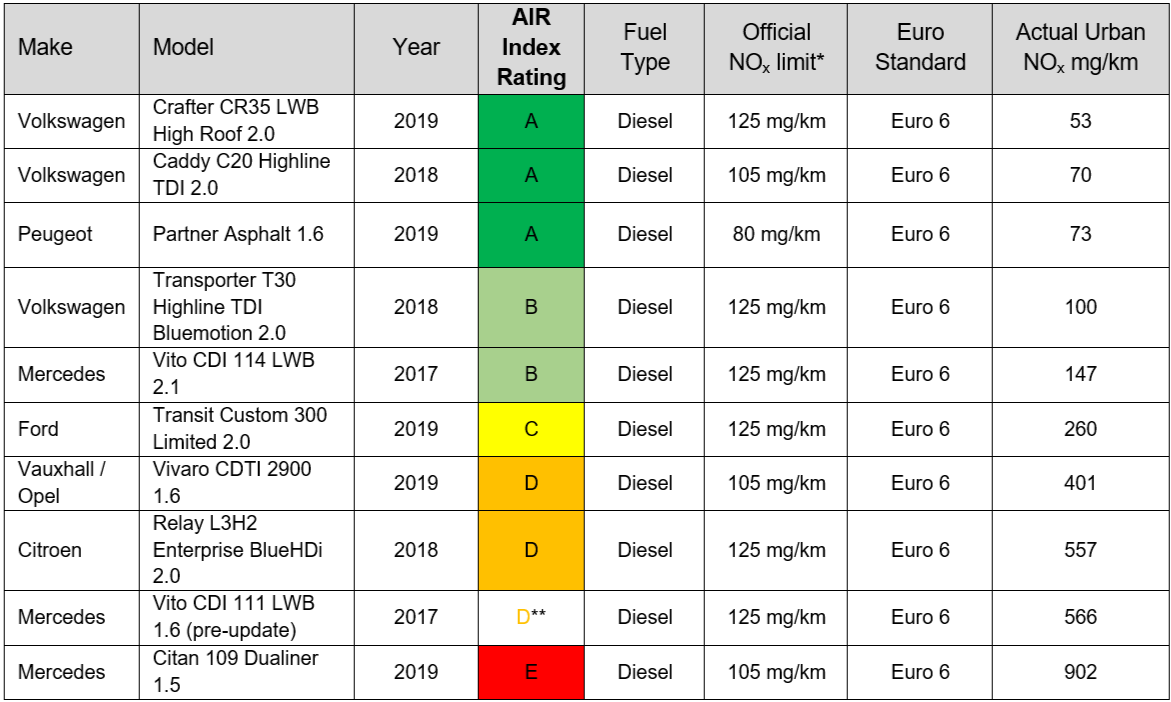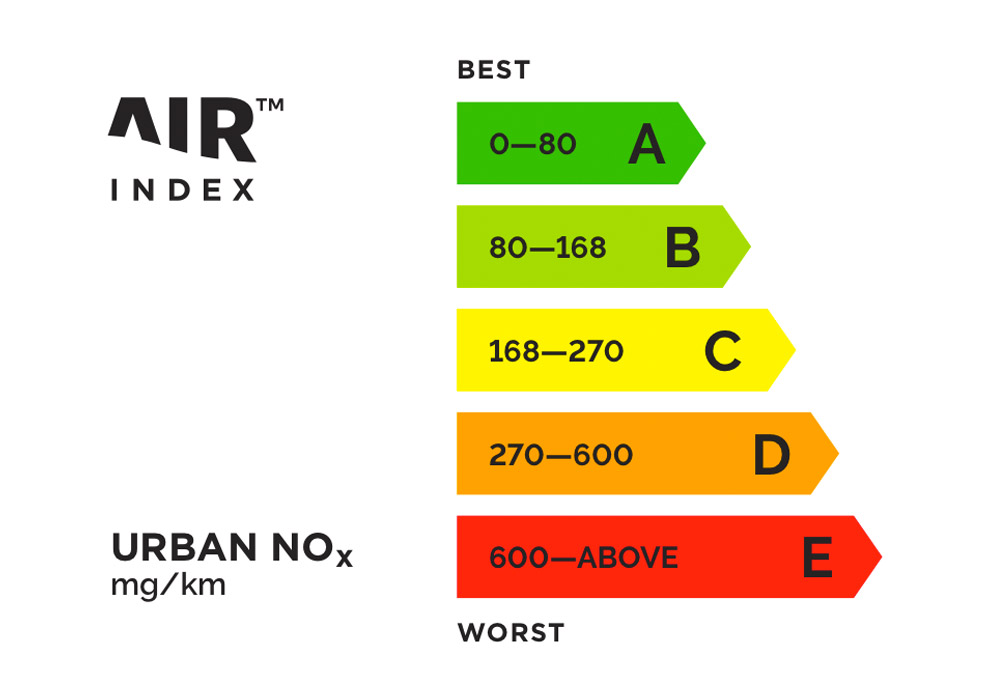Christmas Home Delivery Shock: Dirtiest Parcel Vans are 17 Times More Polluting than Cleanest, Says AIR Index
Independent real-world rating system’s tests found a huge variation in van emissions – pointing to a major impact on urban emissions over the festive period
- From Black Friday to Christmas, the festive season adds an extra 19,000 light commercial vehicles to our roads to cope with increased parcel deliveries
- The vast majority of those vans are diesel, but not all are the same when it comes to real-world tailpipe emissions
- The AIR Index reveals that the Mercedes Citan has the worst emissions of the best-selling Euro 6 light commercial vehicles (LCVs) tested, emitting 17 times more NOx than Volkswagen’s Crafter, one of the lowest emitters
- But the AIR Index also shows that manufacturer-led updates of a van’s engine management system can slash emissions easily and quickly
- Vans are a vital part of our transport network and have a major role to play in cleaning up urban air quality – the AIR Alliance calls on manufacturers rapidly to roll-out emissions updates and advises van buyers and policymakers to use the index to identify the cleanest vehicles
- More information available at the AIR Index website www.airindex.com
- Images and video available http://bit.ly/AIR_NOx and https://youtu.be/kxpOPPIeSy4
17 December 2019 – Would you rather 17 vans arrived at your home to deliver a Christmas parcel or just the one? That’s the difference in emissions between the dirtiest and cleanest home delivery van as tested by the AIR Index, and it’s adding to an urban pollution crisis that not only peaks over the festive season but is a growing problem throughout the year.
With retail events such as Black Friday, Cyber Monday and the month-long run up to Christmas, combined with the growth in online shopping, demand for home delivery is still growing rapidly. Staveley Head, courier insurers found that parcel delivery increased by 11 percent last year; delivery companies such as Royal Mail, Hermes, DPD, Yodel and UPS are increasing the number of vehicles on the road to cope, adding 19,000 extra vans to the network during the festive period.
But even if the majority of those vans are the latest Euro 6 diesels, not all of them have the same real-world tailpipe emissions. The AIR Alliance, publishers of the AIR Index – an international, independent and standardised rating system that reveals accurately how much pollution a vehicle produces when it is used in towns and cities – tested some of the best-selling Euro 6 diesel vans in Europe, giving each vehicle a simple A-E colour-coded rating according to the latest CWA17379 methodology.
The results reveal the huge difference between real-world emissions and laboratory-based legal limits. For instance, the 2019 Volkswagen Crafter is rated an ‘A’ on the AIR Index, emitting 53 mg/km NOx, 72 mg less than the large-van (Class III) laboratory-based legal limit of 125 mg/km, but the 2019 Mercedes Citan is rated an ‘E’ on the AIR Index, emitting 902 mg/km of NOx, more than 8 times the (Class II) light-van laboratory-based legal limit of 105 mg/km – and 17 times more polluting than the Volkswagen.
If the extra 19,000 vans added to the network over the festive period were all Volkswagen Crafters rather than Mercedes Citans, 1kg of NOx would enter the urban area rather than 17.1kg. With the average parcel van travelling between 20,000 and 30,000 miles a year – in other words up to 20,000 miles further than a passenger car – and every day some 65,000 unique LCV journeys being made into London by vans alone, the scale of the emissions problem is easy to see.
Created to inform and empower consumers, owner-drivers, fleet operators and policy makers with the real facts about emissions when making choices about vehicle purchase and usage, the AIR Index is a vital tool in helping to clean up urban air quality.
The AIR Alliance tested a cross-section of the best-selling vans in Europe equating to half of the two million new vans registered in 2017. All of the vans tested meet the Ultra-Low Emissions Zone standards in London. The AIR Index ratings showed that of the 10 vans tested, only three received an ‘A’ rating, yet all can be driven through the Ultra Low Emission Zone without penalty:

Shocking as this table is, the power dramatically and rapidly to improve emissions from dirty vans lies within the hands of the manufacturers. For example, AIR found that when it commissioned a test of the Mercedes Vito CDI 111 LWB 1.6, a simple manufacturer-led update of the vehicle’s emissions management system halved the NOx emissions when tested again. This would be the equivalent of improving the AIR Index rating from ‘D’ to ‘C’.
Massimo Fedeli, Co-founder and Operations Director, AIR said: “Christmas is a time for giving and this year we urge van manufacturers to give us cleaner air. The ultimate responsibility to implement change lies with them: simple service-led engine management updates can make vans much cleaner, dramatically reducing emissions immediately.
“In the short term, we hope that those in charge of purchasing van fleets and making policy around ULEZ will use the AIR Index so that they are better equipped to know which vans are the cleanest, allowing them to choose the greenest vehicles, helping tackle the air crisis we are currently battling.”
Nick Molden, co-founder of AIR said: “Vans play a vital role in moving goods quickly and efficiently around our cities – over the Christmas period their mileage increases enormously, so it is crucial that only the cleanest vans are allowed to enter urban areas. Euro standards alone will not deliver the expected air quality improvements in towns or cities. The use of independent, trusted emissions ratings from the AIR Index offer a faster and more effective route to clean urban air, helping policy makers limit the impact of harmful emissions in towns and cities.”
ENDS
Media contacts
Email PressOfficer@allowAIR.org
Call +44 (0) 7815 863 968
About the AIR Index
Cars and vans rated for the AIR Index are tested according to the CWA 17379 standardised methodology which ensures that the results are independent, comparable and can be used as the basis for a legal framework for vehicle policies.
The testing is carried out on at least two vehicles, sourced independently from vehicle manufacturers with portable emissions testing units (PEMS) recording actual on-road driving in towns and cities. For a result to be considered acceptable for rating in the AIR Index there must be at least five, 10 km trips completed during three separate journeys on at least two matching vehicles in line with the CEN standard.
The results of the tests provide the basis to rate the vehicle according to the A-E, colour-coded scale.

The AIR Index website includes more than 200 results of the first tests conducted with ratings A-E, but also provides a facility to check other vehicles on the road to see if they would be allowed access (or not) to the 14 German cities which have set a NOx limit of 270 mg/km under the Federal Emissions Control Act.
Other cities across Europe are considering a similar threshold to control access and allow only the cleanest cars to enter. Car and van buyers should consider carefully the implication for a vehicle’s residual value, and their own mobility requirements, if it is unable to enter a town or city where emissions are controlled.
About AIR
AIR (Allow Independent Road-testing) is an independent alliance of public and private organisations, which promotes the voluntary uptake of independent on-road emissions testing.
The alliance’s key objective is to contribute to delivering a cost-effective and timely reduction in harmful vehicle emissions in urban areas, while ensuring the lowest CO2 emissions from the global vehicle fleet.
AIR seeks to empower citizens, industry and public authorities to take informed decisions on their mobility practices and policies by promoting full transparency on vehicle emission levels.
Scientific Advisory Committee
The development of the AIR Index has been led by the world’s leading academics in the fields of emissions and air quality and they make up AIR’s Scientific Advisory Committee (SAC).
- Professor Helen ApSimon, Professor of Air Pollution Studies, Imperial College London.
- Dr Adam Boies, Reader in the Energy Division, Department of Engineering, University of Cambridge.
- Dan Carder, Director for Alternative Fuels, Engines and Emissions, West Virginia University.
- Dr Claire Holman, Chair, Institute of Air Quality Management.
- Dr Guido Lanzani, Head of Air Quality Unit, Regional Environmental Agency, Lombardy Region.
- Dr Norbert Ligterink, Senior Research Scientist, TNO.
- Martin Lutz, Head of Sector Air Quality Management, Berlin Senate Department for Environment, Transport and Climate Protection.
- Dr Xavier Querol, Institute of Environmental Assessment and Water Research, Spanish Council for Scientific Research.
- Dr Marc Stettler, Lecturer in Transport and the Environment, Centre for Transport Studies, Imperial College London.
- Professor Martin Williams, Professor of Air Quality Research, Kings College London.
Notes on European Air Quality
The European Environment Agency provides independent information on the environment for those involved in developing, adopting, implementing and evaluating environmental policy and the general public. In its latest report, published in April 2018, updated in May 20191, the European Environment Agency stated that for particles and nitrogen dioxide, because of the widespread exceedance levels in urban areas, it is unlikely that the air quality standards for these pollutants will be met by 2020 across the EU.
1 see https://www.eea.europa.eu/airs/2018/environment-and-health/outdoor-air-quality-urban-areas
Notes on Parcel deliveries
Courier Insurers, Staveley Head, have collated behind-the-scenes data from some of the UK’s biggest brands including Amazon, Argos, Royal Mail and more with their Black Friday Logistics report.
See https://www.staveleyhead.co.uk/blog/commercial-vehicle/behind-the-scenes-black-friday
Background to the AIR Index testing process
Emissions Analytics, founded by Nick Molden (Co-founder of AIR), was a pioneer in methodologies to test on-road emissions using Portable Emissions Systems (PEMS) equipment. The experience and insight gained from more than 2,000 tests conducted by EA informed the development of the CWA 17379 protocol on which the AIR Index rating is based.
Emissions Analytics has licensed the use of its data including the EQUA Index within the AIR Index database, enabling insight for car buyers and policy makers as to whether vehicles are allowed access (or not) to enter cities which have set a NOx limit of 270 mg/km.
Further information about Allow Independent Road-testing (AIR) can be found at www.airindex.com